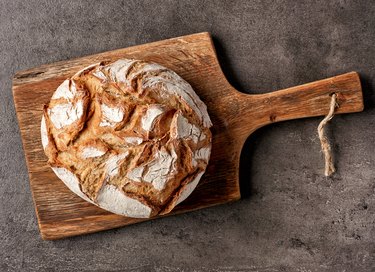
Nothing warms the heart or belly better than fresh-baked bread right out of the oven. When baking bread in a convection oven, you may be able to have your fresh bread out of the oven a little faster.
The Convection Oven
Video of the Day
Your convection oven looks a lot like your conventional oven, but its heating mechanism is a little different. This difference may have you wondering if baking bread in convection oven will give you the same results as your conventional oven.
Video of the Day
In your traditional oven, the heat that bakes the bread rises from the bottom of the oven. This stationary heat may lead to differences in temperature throughout your oven, which can lead to uneven baking of your bread. By comparison, the heat in a convection oven is circulated by fans, which creates an even distribution of the heat in the oven and around your food.
In addition to more even baking of your bread, a convection oven can bake the bread up to 25 percent faster and at a lower temperature than a traditional oven. You also don't need to heat a convection oven before baking. These benefits save you time and may lower your energy costs.
Baking Bread in Convection Oven
While a convection oven can bake a delicious loaf of bread, it's important to follow your recipe to the letter to get the results you're looking for. Making good bread takes practice, and the mechanism in which you bake your bread may not play much of a role in the end product.
According to Purdue University, bread recipes fall into two categories: kneaded dough or batter dough. With a kneaded dough recipe, after you've mixed your ingredients you have to work, or knead, the dough before letting it rest and rise.
With a batter dough recipe there's no kneading of the dough prior to the resting and rising. A kneaded dough recipe creates a bread with a soft texture, while batter dough tends to create a coarser texture.
Once your bread is ready for baking, place the dough in the loaf pan and put it in the convection oven. Bake your bread at a temperature 25 degrees Fahrenheit below the baking temperature in your recipe. For example, if you normally bake your bread at 375 degrees Fahrenheit, decrease to 350 degrees Fahrenheit.
Set your timer for 10 minutes less than the recommended baking time. So if your bread requires 30 to 35 minutes, set your timer to go off at 20 minutes. Your bread is done when it reaches an internal cooking temperature of 200 degrees Fahrenheit.
Tip
When baking bread in convection oven, up the nutritional quality of your homemade loaf by swapping out half of the white flour in your recipe for whole-wheat flour, suggests the Oldways Whole Grains Council. Every 1/4 cup of whole-wheat flour adds 3 grams of fiber, according to nutritional data from the USDA.
Convection Oven Baking Recipes
If you're like many home cooks with a convection oven, you may be looking forward to the benefits your oven offers for your holiday baking. Just like with convection oven baking recipes for bread, you want to decrease your baking temperature by 25 degrees Fahrenheit and reduce your cooking time by 10 minutes for cookies, scones, biscuits and meringues.
When first using your convection oven for baking, be sure to closely watch your baked goods. The website Kitchn suggests you start checking for doneness at the halfway mark, which may give you a better idea of how much faster your convection oven bakes compared to your conventional oven.
Are you wondering whether you should use your convection or conventional oven for baking cakes? While your convection oven can help you get all your holiday cookies baked in one afternoon, the fast-cooking oven isn't ideal for baking all sweet treats or breads.
King Arthur Flour recommends you use your conventional oven for baking quick breads, cakes, cupcakes and sweet yeast breads. The convection oven may cook the outside of these baked goods too quickly and leave the center undercooked.
- AJ Madison: "What's the Difference Between a Convection Oven and a Conventional Oven?"
- Purdue University: "Yeast Dough"
- Taste of Home: "Basic Homemade Bread Recipe"
- Oldways Whole Grains Council: "Expert Shares Tips for Baking With Whole Grains"
- USDA FoodData Central: "Whole Wheat Flour"
- Kitchn: "Convection Oven Baking Tips"
- King Arthur Flour: "Convection or No: Which One Should I Bake With?"